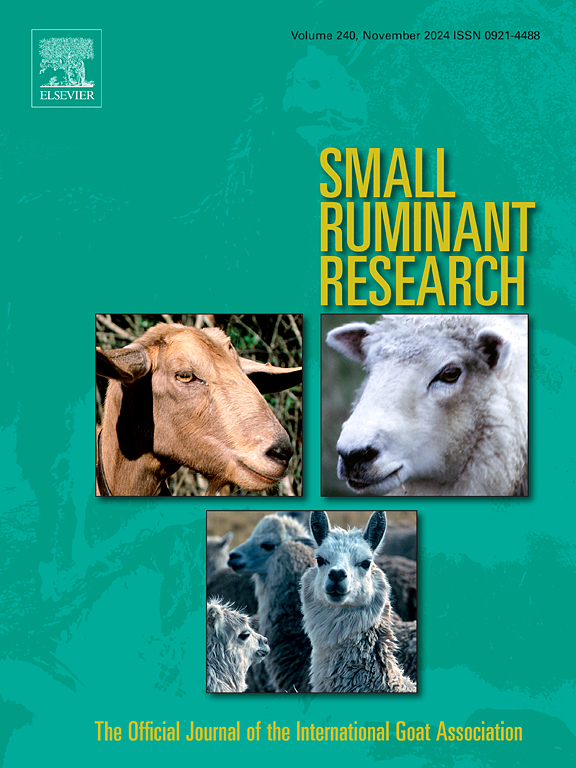The effect of probiotic supplementation in Kamieniec lambs on meat quality
IF 1.6
3区 农林科学
Q2 AGRICULTURE, DAIRY & ANIMAL SCIENCE
引用次数: 0
Abstract
The aim of this study was to evaluate changes in the quality of the Longissimus thoracis et lumborum (LTL) muscle in young suckling rams of the Kamieniec breed administered a probiotic preparation. Beginning at 11 days of age, lambs in the experimental group received an aqueous solution of the tested probiotic (Lactobacillus plantarum - 2 serotypes, Bifidobacterium animalis, Lactobacillus raminosus) per os for 30 days. The dose of the probiotic was adjusted for lamb age: 11–20 days - 1 g, 21–30 days - 2 g, 31–40 days - 3 g. The viable count per g of the probiotic was 109 CFU. At the end of the experiment, lambs of the control (C, n = 6) and experimental (E, n = 6) groups were slaughtered, and samples of their LTL muscles were subjected to analyses. In group E, the LTL muscle had a lower (P ≤ 0.05) pH value, and a lower (P ≤ 0.05) contribution of yellowness (b*) to the color. A sensory analysis of lamb meat in group E revealed its lower (P ≤ 0.05) juiciness, and a tendency (P > 0.05) towards higher desirability of aroma and taste, lower intensity of these attributes, and higher tenderness. In group E, intramuscular fat (IMF) was characterized by higher (P ≤ 0.05) proportions of fatty acid C18:1 cis9 and total MUFAs, a higher (P ≤ 0.05) MUFA/SFA ratio, and higher (P ≤ 0.05) nutritional value. In group C, IMF had higher (P ≤ 0.05) concentrations of fatty acids C18:3 and C20:1. The results of this study indicate that 30-day supplementation with the tested probiotic improves meat quality in very young lambs of the Kamieniec breed.
添加益生菌对克眠羔羊肉品质的影响
本研究的目的是评价在给予益生菌制剂后,幼龄哺乳公羊胸腰最长肌(LTL)肌肉质量的变化。从11日龄开始,试验组羔羊每隔10天饲喂所测益生菌(植物乳杆菌- 2血清型、动物双歧杆菌、猪乳杆菌)水溶液,持续30 d。根据羔羊日龄调整益生菌的剂量:11-20日龄1 g, 21-30日龄2 g, 31-40日龄3 g。每g益生菌的活菌数为109 CFU。试验结束时,分别屠宰对照组(C, n = 6)和试验组(E, n = 6)羔羊,取其LTL肌样本进行分析。E组LTL肌pH值较低(P ≤ 0.05),黄度(b*)对颜色的贡献较低(P ≤ 0.05)。对E组羊肉的感官分析表明,E组羊肉的多汁性较低(P ≤ 0.05),香气和口感的要求较高(P >; 0.05),这些属性的强度较低,嫩度较高。E组肌内脂肪(IMF)的特点是脂肪酸C18:1 cis9和总MUFA比例较高(P ≤ 0.05),MUFA/SFA比值较高(P ≤ 0.05),营养价值较高(P ≤ 0.05)。C组IMF脂肪酸C18:3和C20:1浓度较高(P ≤ 0.05)。本研究结果表明,添加30天所测试的益生菌可改善Kamieniec品种极幼羔羊的肉品质。
本文章由计算机程序翻译,如有差异,请以英文原文为准。
求助全文
约1分钟内获得全文
求助全文
来源期刊

Small Ruminant Research
农林科学-奶制品与动物科学
CiteScore
3.10
自引率
11.10%
发文量
210
审稿时长
12.5 weeks
期刊介绍:
Small Ruminant Research publishes original, basic and applied research articles, technical notes, and review articles on research relating to goats, sheep, deer, the New World camelids llama, alpaca, vicuna and guanaco, and the Old World camels.
Topics covered include nutrition, physiology, anatomy, genetics, microbiology, ethology, product technology, socio-economics, management, sustainability and environment, veterinary medicine and husbandry engineering.
 求助内容:
求助内容: 应助结果提醒方式:
应助结果提醒方式:


